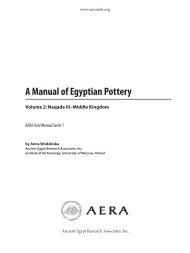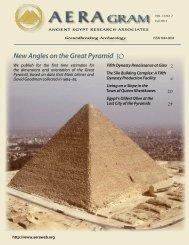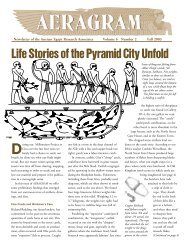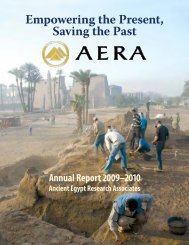The Khentkawes Town (KKT) - Ancient Egypt Research Associates
The Khentkawes Town (KKT) - Ancient Egypt Research Associates
The Khentkawes Town (KKT) - Ancient Egypt Research Associates
Create successful ePaper yourself
Turn your PDF publications into a flip-book with our unique Google optimized e-Paper software.
www.aeraweb.org<br />
ruins that must have badly eroded since they were first<br />
exposed in 1932. A mapping of the <strong>KKT</strong> much later than the<br />
conclusion of its 1932 excavation might also explain why<br />
the buried building, while probed and certainly known,<br />
never made it into the map. Drift sand had rapidly filled<br />
the probe trenches by the time the RAF photos were taken,<br />
and maybe by the time ground survey was done for the<br />
map that Selim Hassan published. We should note that<br />
the plaster and wood survey markers comprise a grid that<br />
does not match that of Selim Hassan’s map of the Central<br />
Field (see large color fold-out in Hassan 1943).<br />
Stairway to Heaven<br />
Once Olchowska worked through the spoil heaps,<br />
patches, and pits from previous digging, and after we<br />
excavated all the brown crusty sand deposited after 1932,<br />
the team moved deeper along the steeply sloping face of<br />
the mudmass directly east of the <strong>Khentkawes</strong> causeway<br />
by removing sand with mud spots that had no doubt been<br />
cast back into a trench that workers dug previously in the<br />
same place and for the same purpose (fig. 37). This bank<br />
contained articulated mudbricks, tumbled mudbrick,<br />
and crushed limestone debris that extended out 2.25 m<br />
from the bedrock face and descended from 18.44 m asl at<br />
the end of the causeway threshold to 17.18 m. Whatever<br />
structure was embedded in this material had eroded into<br />
a steep slope of about 30°.<br />
That structure began to announce itself as we descended.<br />
A roughly vertical marl plaster line against articulated (as<br />
opposed to tumbled out of place) mudbricks appeared to<br />
be the northern wall of a structure (fig. 38). <strong>The</strong> plastered<br />
bricks lean in to the south with a pronounced slope or<br />
batter like a retaining wall. <strong>The</strong> western wall of the buried<br />
building that Yeomans found in 2007 butted up against<br />
the battered face. At first we began to think of a steep<br />
stairway straight up from east to west to the threshold of<br />
the causeway, a stairway to the “Doors of Heaven,” as the<br />
pyramid valley temples might have been known according<br />
to an article by <strong>Egypt</strong>ologist Edward Brovarski (1977). But<br />
if this battered wall on the north framed a stairway up to<br />
the causeway we could not find the corresponding framewall<br />
on the south.<br />
Instead we could see a nearly continuous band of<br />
white limestone debris on a gradual slope down to the<br />
south through the dark bank of the mudmass (figs. 38–39).<br />
Our Eureka moment came when we realized this whitish<br />
Figure 37. Kasia Olchowska points to the section of a<br />
deep pit that she cleared of post-1932 fill. Selim Hassan’s<br />
workers dug the pit to find the bottom of the bedrock<br />
edge and floor of the lower terrace on which the buried<br />
building was founded. <strong>The</strong> workers remove clean sand<br />
with mud spots from in front of the causeway threshold.<br />
View to the south.<br />
40<br />
Giza Plateau Mapping Project Season 2008 Preliminary Report











